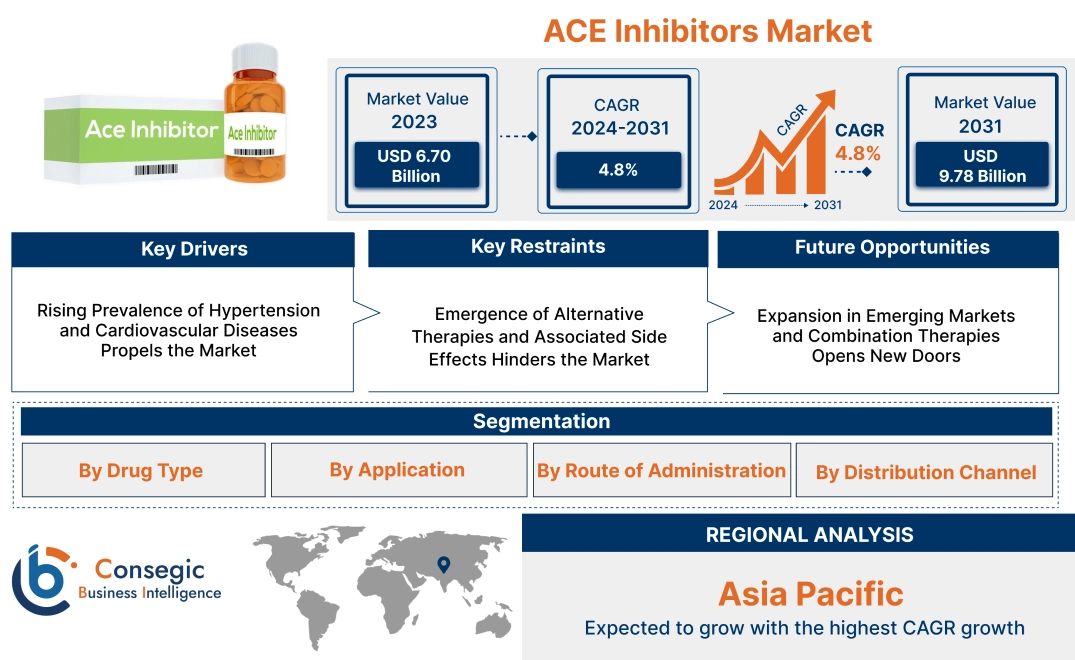ACE Inhibitors Market Size:
ACE Inhibitors Market size is estimated to reach over USD 11.23 Billion by 2032 from a value of USD 6.91 Billion in 2024 and is projected to grow by USD 7.22 Billion in 2025, growing at a CAGR of 5.03% from 2025 to 2032.
ACE Inhibitors Market Scope & Overview:
ACE inhibitors, or angiotensin-converting enzyme inhibitors, are medicines which help in reducing blood pressure as well as treat heart failure, high blood pressure, and kidney diseases by blocking the conversion of angiotensin-converting enzyme. Additionally, ACE inhibitors help relax blood vessels, reduce blood pressure, and improve the efficiency of the heart. The hospitals and clinics are utilizing angiotensin-converting enzyme inhibitors to manage chronic conditions effectively. Further, the inhibitors are majorly used in industries such as pharmaceuticals and healthcare is driving the ACE inhibitors industry.
How is AI Impacting the ACE Inhibitors Market?
Artificial Intelligence (AI) helps by accelerating drug discovery and development, which in turn reduces costs and time required for development. Also, AI optimizes clinical trials, leading to efficient patient sorting, monitoring, and care. Further, AI helps in developing personalized treatments for conditions such as hypertension and other diseases, is driving the adoption of angiotensin-converting enzyme inhibitors. Furthermore, AI can optimize distribution routes and processes, making the supply chain more efficient and cost-effective. AI-powered chatbots can answer patient questions about angiotensin-converting enzyme inhibitors to provide actionable insights for strategic planning.
ACE Inhibitors Market Dynamics - (DRO) :
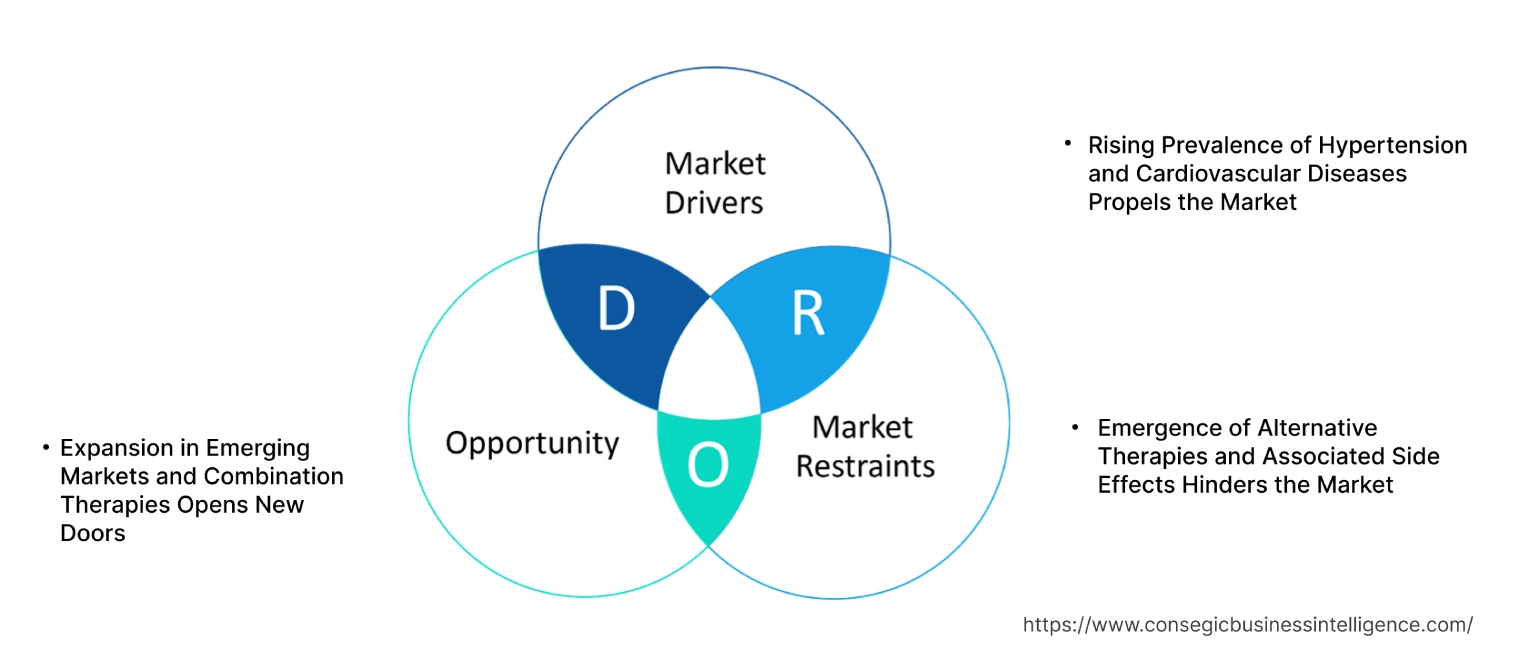
Key Drivers:
Growth in Cardiovascular Diseases Drives Demand for ACE inhibitors
The rising incidence and prevalence of cardiovascular diseases (CVDs), particularly hypertension and heart failure, are the primary factors driving the ACE inhibitors market demand. Additionally, the angiotensin-converting enzyme inhibitors helps to effectively manage blood pressure and reduce strain on the heart, making them essential for treating and preventing life-threatening cardiac conditions. Further, the rising adoption of preventive healthcare and early intervention strategies is boosting the ACE inhibitors market growth.
- For instance, in May 2023, according to World Heart Federation, Death due to cardiovascular disease (CVD) has increased from 12.1 million in 1990 to 20.5 million in 2021 across the globe is driving the need for angiotensin-converting enzyme inhibitors.
Therefore, the rising prevalence of cardiovascular diseases is driving the adoption of angiotensin-converting enzyme inhibitors, in turn, proliferating the growth of the market.
Key Restraints :
Availability of Alternative and Side Effects Associated are Restraining the Market Growth
The availability of other drug classes that effectively manage hypertension such as diuretics, beta-blockers and calcium channel blockers among others is hindering the ACE inhibitors market expansion. Additionally, some of the common side effects include dry cough, dizziness, low blood pressure (hypotension), and headaches among others are hindering the ACE inhibitors market expansion. Further, some of the serious side effects include swelling of the face, lips, tongue, or throat, which can be life-threatening and require immediate medical attention, which is restraining the market progress. Furthermore, the rising adoption lower-cost generic drugs can reduce overall market revenue for angiotensin-converting enzyme inhibitors.
Therefore, the availability of other drug classes and aforementioned side effects are restraining the market growth.
Future Opportunities :
Ongoing Research and Development is expected to promote potential opportunities for market growth
The increasing prevalence of hypertension and heart failure, as well as the rise in global health awareness is paving the way for ACE inhibitors market opportunities. Additionally, pharmaceutical companies are investing in research to create new angiotensin-converting enzyme inhibitors from natural products for treating other cardiovascular conditions and diseases is driving the market evolution. Further, the government initiatives and policies to improve the accessibility of angiotensin-converting enzyme which in turn encourages research and market progress.
- For instance, according to National Library of Medicine, The ongoing research in the field of discovering new angiotensin-converting enzyme inhibitorsfrom natural products, focusing on peptides with favorable characteristics is driving the market development.
Hence, the ongoing research is anticipated to increase the utilization in turn promoting prospects for ACE inhibitors market opportunities during the forecast period.
ACE Inhibitors Market Segmental Analysis :
By Drug Type:
Based on the drug type, the market is segmented into captopril, enalapril, lisinopril, ramipril, fosinopril, quinapril, benazepril, and others.
Trends in the Drug Type:
- The improving healthcare access is boosting the prescription rates of medications like enalapril for managing blood pressure and preventing complications is driving the ACE inhibitors market trends.
- The increased investment in healthcare infrastructure and demand for medications such as lisinopril, ramipril and others is driving the ACE inhibitors market trends.
The lisinopril accounted for the largest revenue share in the year 2024.
- Lisinopril is majorly used for managing hypertension and heart failure and is one of widely prescribed angiotensin-converting enzyme inhibitors.
- They offer a range of benefits including lowers blood pressure and increases the supply of blood and oxygen to the heart consequently is driving the ACE inhibitors market share.
- Further, the effectiveness in treating hypertension and managing conditions like heart failure is driving the adoption of lisinopril which sequentially is boosting the ACE inhibitors market growth.
- Furthermore, the growing prevalence of cardiovascular diseases(CVD) and chronic kidney disease is driving the need for lisinopril which in turn is boosting the ACE inhibitors market demand.
- Thus, as per the market analysis, the aforementioned factor is driving the adoption of lisinopril and consecutively is fueling the market trends.
The ramipril is anticipated to register the fastest CAGR during the forecast period.
- Ramipril is primarily utilized for applications, including hypertension, heart failure, and others.
- The rising number of clinical studies validating the efficacy of ramipril is boosting the adoption by healthcare providers for preventing cardiovascular-related mortality.
- Further, the increasing number of CVDs and rising awareness among healthcare providers are expected to fuel the need for ramipril consequently is driving the ACE inhibitors market share.
- Thus, the ACE inhibitors market analysis shows that Ramipril is expected to grow rapidly due to increasing number of CVDs as well as proven cardioprotective benefits among high-risk patient groups.
By Application:
Based on the application, the market is segmented into hypertension, congestive heart failure (CHF), chronic kidney disorders, cardiovascular diseases (CVDs), and others.
Trends in the Application:
- The trend towards the improvements in long-term survival and clinical outcomes for adopting angiotensin-converting enzyme inhibitors to treat congestive heart failure and hypertension is boosting the market progress.
- The trend towards increasing number of people with cardiovascular diseases, including heart failure and coronary artery disease is driving the adoption of angiotensin-converting enzyme inhibitors.
The hypertension accounted for the largest revenue share of 45.50% in the year 2024.
- Hypertension is the most common cause of CVDs and angiotensin-converting enzyme inhibitorsare utilized to lower blood pressure by relaxing blood vessels helping reduce hypertension.
- Additionally, the global change in lifestyles, as well as rising prevalence of unhealthy diets, and aging populations are contributing to the rise in hypertension in regions such as North America and Europe consequently is driving the ACE inhibitors market size.
- Further, angiotensin-converting enzyme inhibitorsare considered a first-line therapy for hypertension management, due to the increasing validation of the link between hypertension and other severe conditions like stroke.
- Thus, as per the market analysis, the rising prevalence of hypertension cased is driving the market demand.
The chronic kidney disorders (CKD) is anticipated to register the fastest CAGR during the forecast period.
- ACE inhibitors are widely used to manage chronic kidney disorders, as they help slow down the progression of kidney damage.
- Further, the rising number of incidences of diabetes and hypertension globally has surged, the need for angiotensin-converting enzyme inhibitors for treating chronic kidney disorders.
- Furthermore, the ability of inhibitors to protect kidneys, especially for patients with diabetics, is driving the market progress.
- The rising benefits of CKD management is expected to increase the need for angiotensin-converting enzyme inhibitors.
- Therefore, as per the market analysis, the aforementioned factors are anticipated to boost the market during the forecast period.
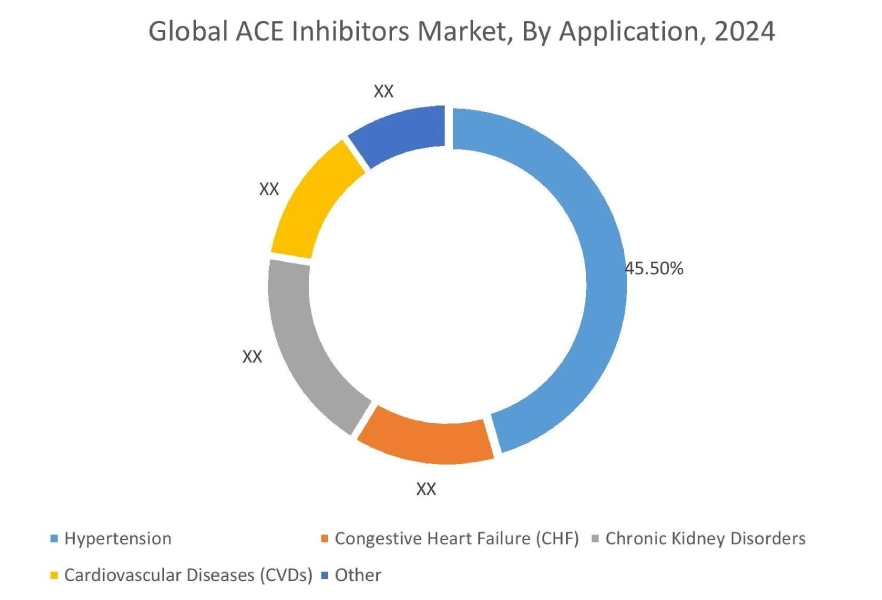
By Route of Administration:
Based on the route of administration, the market is segmented into oral and intravenous.
Trends in the Route of Administration:
- The conditions where rapid action is required in critical patient conditions intravenous administration are essential which in turn is fueling the market.
- The trend towards tailored oral dosage for angiotensin-converting enzyme inhibitors to patients with chronic diseases is driving the market progress.
The oral route of administration accounted for the largest revenue share in the year 2024.
- Oral administration remains the most common route for ACE inhibitors, because of the convenience, cost-effectiveness, and ease of compliance for patients.
- Additionally, lisinopril and ramipril, are available in oral formulations that offer reliable and consistent therapeutic effects is driving the need for oral administration.
- Moreover, the widespread availability of oral formulations across various healthcare systems is boosting the progress of oral administration.
- Further, the long-term management of chronic conditions like hypertension, heart failure, and CKD, makes oral administration a preferred choice by patients.
- Thus, as per the ACE inhibitors market analysis, the convenience and widespread use is driving the progress of oral administration consequently driving the market evolution.
The intravenous route of administration is anticipated to register the fastest CAGR during the forecast period.
- Intravenous administrations are majorly utilized in condition where acute care settings or rapid therapeutic effects are required.
- Additionally, the rise in acute heart failure and hypertensive emergencies where immediate control of blood pressure is critical, drives the need for intravenous administration.
- Further, the continuous advancement in hospitals and emergency care settings and for managing acute cardiovascular events the need for intravenous administration is essential.
- Furthermore, the increasing incidence of CVDs emergencies and other cases globally is expected to drive need for intravenous administration.
- Therefore, the continuous advancement as well as increasing incidence of CVDs emergencies and other are anticipated to boost the market during the forecast period.
By Distribution Channel:
Based on the distribution channel, the market is segmented into hospital pharmacies, retail pharmacies, and online pharmacies.
Trends in the Distribution Channel:
- The rise of telemedicine which provides digital prescriptions is driving the need for online pharmacies.
- The rising adoption artificial intelligence to improve inventory management, delivery times, and enhance customer experience in retail pharmacies, and online pharmacies is boosting the market progress.
The hospital pharmacies accounted for the largest revenue share in the year 2024.
- Hospital pharmacies are primary source to acquire angiotensin-converting enzyme inhibitors for patients with heart failure and CKD among others within the facility.
- Additionally, the rising number of cardiovascular hospitals with in-house pharmacies for uninterrupted supply of medications in the hospitals is driving the progress of hospital pharmacies segment consequently is driving the ACE inhibitors market size.
- Further, the increased public awareness of hypertension and growing aging population is driving the need for hospital pharmacies.
- Thus, as per the market analysis, the rising number of cardiovascular hospitals with in-house pharmacies is driving the progress of hospital pharmacies segment.
The online pharmacies is anticipated to register the fastest CAGR during the forecast period.
- The growing patient preference for convenience and accessibility, particularly in regions with limited healthcare access, is driving the need for online pharmacies.
- Additionally, the expansion of e-commerce in the pharmaceutical industry has made online pharmacies a rapidly growing distribution channel.
- Further, the key factors diving the progress of online pharmacies include cost savings through discounts and lower overhead, rising internet and smartphone penetration and others.
- Therefore, as per the market analysis, the aforementioned factors are anticipated to boost the market during the forecast period.
Regional Analysis:
The regions covered are North America, Europe, Asia Pacific, Middle East and Africa, and Latin America.
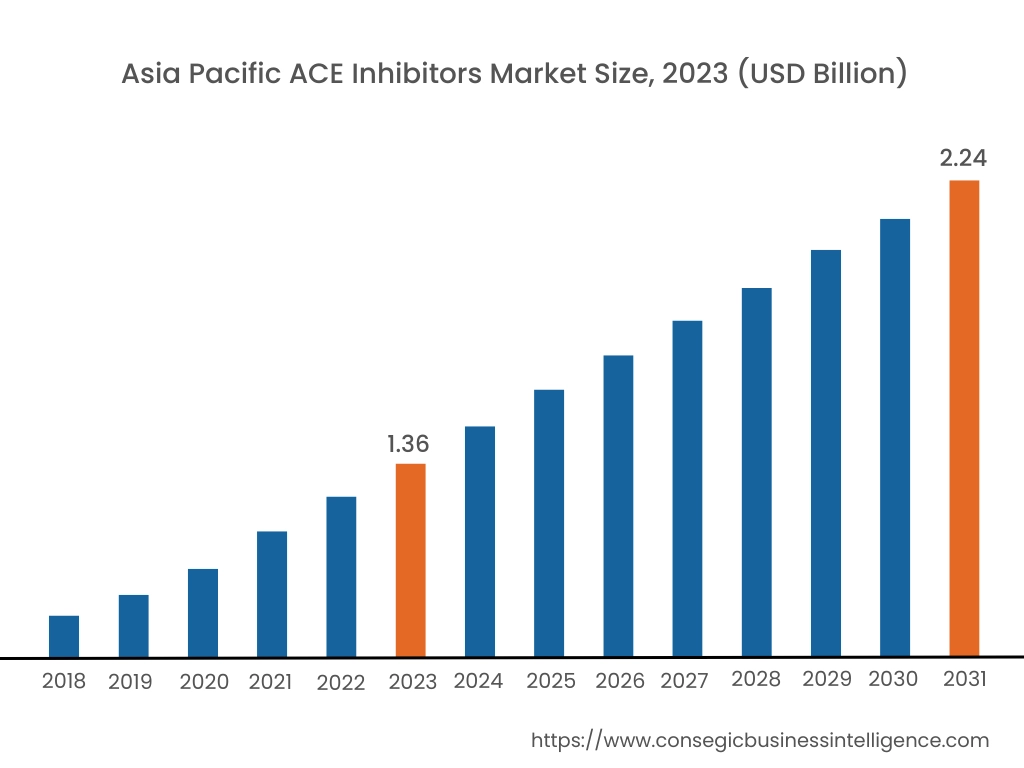
Asia Pacific region was valued at USD 1.85 Billion in 2024. Moreover, it is projected to grow by USD 1.94 Billion in 2025 and reach over USD 3.10 Billion by 2032. Out of this, China accounted for the maximum revenue share of 36.14%. The market progress is mainly driven by large populations and rising incidence of cardiovascular diseases. Furthermore, factors including urbanization, changes in lifestyle, and increasing rates of obesity and diabetes are projected to drive the market progress in Asia Pacific region during the forecast period. Also, the rising investments in healthcare industry and expanding access to pharmaceuticals is boosting the adoption of angiotensin-converting enzyme inhibitors.
- For instance, according toIndia Brand Equity Foundation, around 634,561 foreign tourists came to India for medical treatment which accounted for 6.87% of the total international tourists visited in 2023 which shows a developing healthcare sector as well as building trust among patients across globe for seeking advanced treatment.
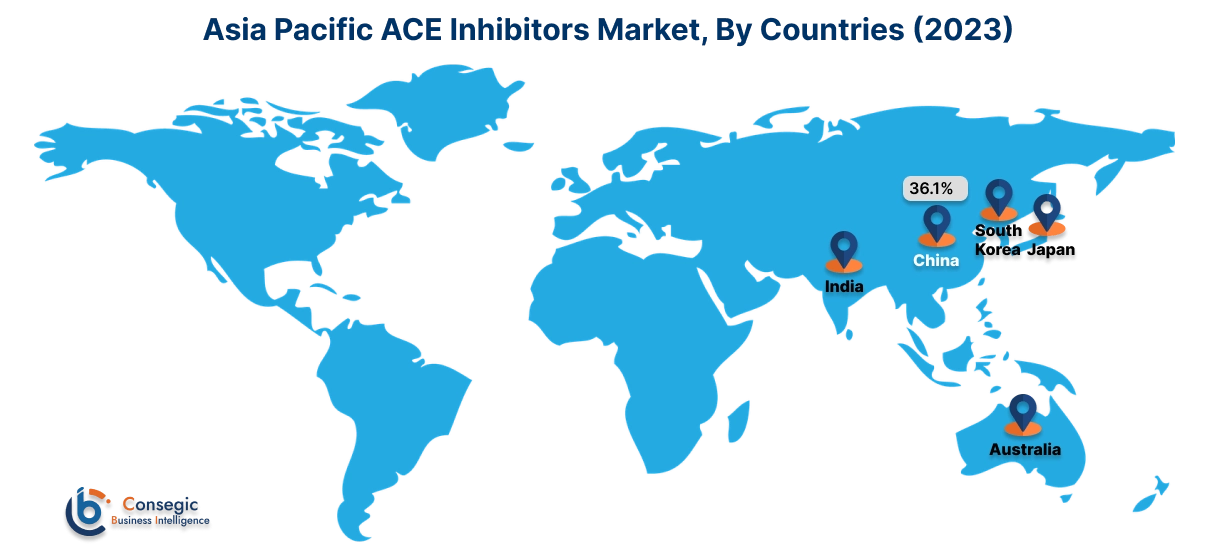
North America is estimated to reach over USD 3.66 Billion by 2032 from a value of USD 2.23 Billion in 2024 and is projected to grow by USD 2.33 Billion in 2025. The North American region's growing number of hypertension and cardiovascular diseases offer lucrative growth prospects for the market. Additionally, the well-established healthcare infrastructure and a large aging population are driving the market progress. Further, the rising awareness of cardiac health and the availability of innovative pharmaceuticals care is driving the market progress.
- For instance, according to Institute for Health Metrics and Evaluation, the government of US have invested approximately USD 4.3 trillion in the healthcare sector due to rising number of cardiovascular diseases, overweight or obesity and others.
The regional analysis depicts that the growing awareness among consumers about preventive care and management of chronic diseases by government is driving the market in Europe. Additionally, the key factor driving the market is the government initiatives to improve healthcare access and rising rates of hypertension and cardiovascular diseases is propelling the market adoption in the Middle East and African region. Further, the increasing health consciousness and a rising demand for natural health products is paving the way for the progress of the market in Latin America region.
Top Key Players & Market Share Insights:
The global ACE Inhibitors market is highly competitive with major players providing ACE Inhibitors to the national and international markets. Key players are adopting several strategies in research and development (R&D), product innovation, and end user launches to hold a strong position in the ACE Inhibitors industry. Key players in the ACE Inhibitors market include-
- Pfizer Inc.(USA)
- Novartis International AG(Switzerland)
- Bristol-Myers Squibb Company (USA)
- Abbott Laboratories (USA)
- Teva Pharmaceutical Industries Ltd. (Israel)
- Merck & Co., Inc. (USA)
- Sanofi S.A. (France)
- Johnson & Johnson (USA)
- Mylan N.V. (USA)
- AstraZeneca (UK)
ACE Inhibitors Market Report Insights :
| Report Attributes | Report Details |
| Study Timeline | 2019-2032 |
| Market Size in 2032 | USD 11.23 Billion |
| CAGR (2025-2032) | 5.03% |
| By Drug Type |
|
| By Application |
|
| By Distribution Channel |
|
| By Route of Administration |
|
| By Region |
|
| Key Players |
|
| North America | U.S. Canada Mexico |
| Europe | U.K. Germany France Spain Italy Russia Benelux Rest of Europe |
| APAC | China South Korea Japan India Australia ASEAN Rest of Asia-Pacific |
| Middle East and Africa | GCC Turkey South Africa Rest of MEA |
| LATAM | Brazil Argentina Chile Rest of LATAM |
| Report Coverage |
|
Key Questions Answered in the Report
How big is the ACE Inhibitors market? +
The ACE Inhibitors market size is estimated to reach over USD 11.23 Billion by 2032 from a value of USD 6.91 Billion in 2024 and is projected to grow by USD 7.22 Billion in 2025, growing at a CAGR of 5.03% from 2025 to 2032.
Which segmentation details are covered in the ACE Inhibitors report? +
The ACE Inhibitors report includes specific segmentation details for drug type, application, distribution channel, route of administration, and regions.
Which is the fastest segment anticipated to impact the market growth? +
In the ACE Inhibitors market, the ramipril is the fastest-growing segment during the forecast period due to increasing number of CVDs as well as proven cardioprotective benefits among high-risk patient groups.
Who are the major players in the ACE Inhibitors market? +
The key participants in the ACE Inhibitors market are Pfizer Inc. (USA), Novartis International AG (Switzerland), Merck & Co., Inc. (USA), Sanofi S.A. (France), Johnson & Johnson (USA), AstraZeneca (UK), Bristol-Myers Squibb Company (USA), Abbott Laboratories (USA), Teva Pharmaceutical Industries Ltd. (Israel), Mylan N.V. (USA) and others.
What are the key trends in the ACE Inhibitors market? +
The ACE Inhibitors market is being shaped by several key trends including the rise of telemedicine as well as rising adoption artificial intelligence in online pharmacies and retail pharmacies are the key trends driving the market.
